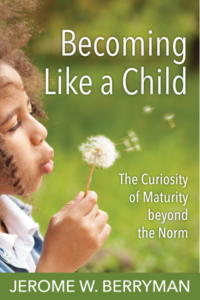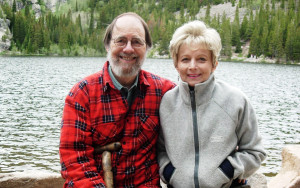A book review and interview with Jerome Berryman, author of Becoming Like a Child: The Curiosity of Maturity Beyond the Norm
by Jeannie Babb
“Truly I tell you, unless you change and become like children, you will never enter the kingdom of heaven” (Matthew 18:3).
Focusing on a single saying of Jesus, Jerome Berryman’s latest work combines decades of research with a lifetime of practice with lively stories from the Godly Play classroom. It’s the kind of book I want to spend much more time with, before saying anything at all. Yet, I also want to share it with you as soon as possible, because I hope you will read it and share it, and we can discuss it.
Becoming Like a Child (Church Publishing, 2017) is the sort of book I’d like to study in a Sunday class or a seminary class. Although the book is in some ways about Godly Play, it is not exactly a monograph. One need not be familiar with the practice, nor even interested in children’s ministry, to read this book and be led into a deeper understanding of Christianity, of the metaphor from which it takes its name, of human nature, and of oneself.
When I ask Berryman how long it took to write this book, he tells me, “Since about 1960.” In 1960, he was a theology student at Princeton. When the standard offering for Christian education did not make sense to him, his professor, the widely respected Dr. D. Campbell Wyckoff, approached the dean with a suggestion for a tutorial instead. In this tutorial, Wyckoff assigned Berryman the task of writing a theory of Christian education.
Berryman says he is still working on that assignment. “It has taken a long time to figure it out. Maybe this book is just another way of doing that.”
Berryman and his wife Thea founded the Godly Play approach to exploring faith with children. Their practice is based on the methods of Maria Montessori and honed by the Berrymans and their trainees over many decades with many roomfuls of children. Godly Play is now used throughout the United States and all around the world. Berryman is the Senior Fellow at the Center for the Theology of Childhood, and author of sixteen books and many other publications.
“I write books that need to be written,” says Berryman in our interview. “They need to be written for different kinds of reasons. I wrote Teaching Godly Play because I was trying to understand what it was Thea and I were doing. When I wrote Children and the Theologians, I wanted to know more about the theology of children. Then came The Spiritual Guidance of Children, to see if I could say what that meant.”
Guiding children spiritually, Berryman explains, is what the Godly Play method actually accomplishes. “Godly Play came from a long tradition of what could be called spiritual guidance,” he says, “beginning with Maria Montessori.”
Becoming Like a Child is a deep exploration of one of the most curious sayings of Jesus, that one does not enter the kingdom of God without becoming like a small child. Some version of this saying appears in every canonical gospel and also the Gospel of Thomas. But what does it mean?
Berryman calls the aphorism a paradox. It is not a call to be immature, he explains in the opening chapter, but rather a call to a childlike state of maturity. Jesus offered the aphorism not as a riddle to solve, but as a paradox to live. “His goal was to change lives,” Berryman notes, “not win arguments” (13).
During our interview, Berryman says that becoming like a child is not only the path into the kingdom of God, but also describes what the Godly Play method seeks to do. “Godly Play helps children and adults achieve a certain kind of maturity beyond the norm, where one stays in the deep current where our deep identity is.”
 Berryman uses a river (image courtesy of Church Publishing) to illustrate this principle. In the book he writes, “Maturity beyond the norm flows when freedom (trending toward chaos) is combined with the ability to sustain continuity (tending toward rigidity) without getting stuck in either.” Drifting into chaos will cause the creative process to fall apart; drifting into the other bank, the creative process “grinds to a halt, breaks down, and dies” (175).
Berryman uses a river (image courtesy of Church Publishing) to illustrate this principle. In the book he writes, “Maturity beyond the norm flows when freedom (trending toward chaos) is combined with the ability to sustain continuity (tending toward rigidity) without getting stuck in either.” Drifting into chaos will cause the creative process to fall apart; drifting into the other bank, the creative process “grinds to a halt, breaks down, and dies” (175).
Berryman tells me he first used the allegory of the river in an article years ago, and found that it articulates the aim of Godly Play in a concise way that resonates for many people. “The river, as it flows, needs to be in touch with both banks.”
Berryman’s study ranges widely, covering hundreds of experts of children, theology, and life stages. For example, he explores the work of Joan and Erik Erikson. The Eriksons described nine stages of psychosocial development, each with its own crisis. At each stage, creativity or play is an important way one works through the conflict. For example, Jerome writes, “Play’s contribution to human development begins when children learn to trust the ‘world’ (mostly the mother) by poking, nuzzling, and playing with it” (61).
The ninth stage of development is depicted as a walk backward through the previous eight stages. In the expanded final version of the Eriksons’ final book, The Lifecycle Completed, this idea is explored in detail. Toward the end of life, many elders experience a trust/mistrust dilemma again as they begin to mistrust their own bodies and capabilities. Play and playfulness continue to be avenues for resolving these crises.
Godly Play is sometimes used in assisted living facilities and other adult or elder contexts, with great success. Berryman tells about an Episcopal retirement home in Asheville, NC, that asked him to tell Godly Play stories to the residents. “What was interesting was some of the people could respond but some did not have language anymore due to strokes or other problems. They were all deeply engaged with their senses. You could see it in their level of concentration, and then the tears.” Berryman says that powerful inherited stories “slip through the gates of consciousness, right into the unconscious where the deep work gets done.”
Most adults have our defenses up and we resist that kind of depth, whereas children are more naturally open to surprises. Berryman says that many people in their later years have greater sensitivity to Godly Play and to openess in general. “That’s why they have to work so hard to be in routine. They need a lot of exterior structure.”
By contrast, Berryman notes, “The disciples did not play.” He says, “All they could do, at least at first, was ask serious, culture-bound questions about who was going to be the most important” (63).
Playing is thus a skill, and not merely a given. Because play involves, in the words of Brian Sutton-Smith, “adaptive variability,” it has an ambiguous nature. Berryman writes that play “reopens evolution’s possibilities when we get stuck” (64).
A bit of structure helps provide a sense of safety in the face of the ambiguity of play – but a bit too much structure destroys the creative impulse. Berryman tells me the closed openness of fractals is also a good metaphor for the paradoxical environment Godly Play seeks to create, and the safe openness people need in order to really play. He says the circle closes in a space in which to be open.
Although Berryman’s new book is somewhat academic in format, with footnotes at the bottom of each page, the interweaving of theory and story makes it accessible to all adult readers. Berryman says the intended audience includes those who are interested in Godly Play, from parents to professors, and all those who are interested in the spiritual guidance of children. Becoming Like a Child is available through Godly Play Resources, along with all the major works of Jerome Berryman.





Thank you for this good review. I bought a copy of this book here, in Korea. I’ll start reading from now on.